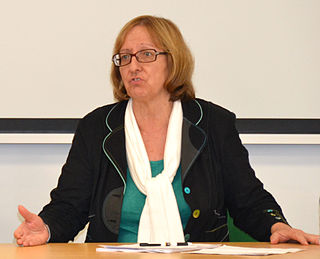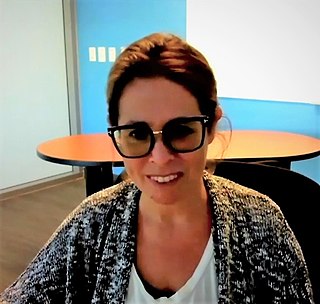Related Research Articles

The immune system is a network of biological systems that protects an organism from diseases. It detects and responds to a wide variety of pathogens, from viruses to parasitic worms, as well as cancer cells and objects such as wood splinters, distinguishing them from the organism's own healthy tissue. Many species have two major subsystems of the immune system. The innate immune system provides a preconfigured response to broad groups of situations and stimuli. The adaptive immune system provides a tailored response to each stimulus by learning to recognize molecules it has previously encountered. Both use molecules and cells to perform their functions.

Polly Celine Eveline Matzinger is a French-born immunologist who proposed the danger model theory of how the immune system works.

The adaptive immune system, also known as the acquired immune system, or specific immune system is a subsystem of the immune system that is composed of specialized, systemic cells and processes that eliminate pathogens or prevent their growth. The acquired immune system is one of the two main immunity strategies found in vertebrates.
Ira Mellman is an American cell biologist who discovered endosomes. He serves as Vice President of Research Oncology at Genentech in South San Francisco, California.

An antigen-presenting cell (APC) or accessory cell is a cell that displays antigen bound by major histocompatibility complex (MHC) proteins on its surface; this process is known as antigen presentation. T cells may recognize these complexes using their T cell receptors (TCRs). APCs process antigens and present them to T-cells.
Pattern recognition receptors (PRRs) play a crucial role in the proper function of the innate immune system. PRRs are germline-encoded host sensors, which detect molecules typical for the pathogens. They are proteins expressed mainly by cells of the innate immune system, such as dendritic cells, macrophages, monocytes, neutrophils, as well as by epithelial cells, to identify two classes of molecules: pathogen-associated molecular patterns (PAMPs), which are associated with microbial pathogens, and damage-associated molecular patterns (DAMPs), which are associated with components of host's cells that are released during cell damage or death. They are also called primitive pattern recognition receptors because they evolved before other parts of the immune system, particularly before adaptive immunity. PRRs also mediate the initiation of antigen-specific adaptive immune response and release of inflammatory cytokines.

The innate, or nonspecific, immune system is one of the two main immunity strategies in vertebrates. The innate immune system is an alternate defense strategy and is the dominant immune system response found in plants, fungi, insects, and primitive multicellular organisms.

An immune complex, sometimes called an antigen-antibody complex or antigen-bound antibody, is a molecule formed from the binding of multiple antigens to antibodies. The bound antigen and antibody act as a unitary object, effectively an antigen of its own with a specific epitope. After an antigen-antibody reaction, the immune complexes can be subject to any of a number of responses, including complement deposition, opsonization, phagocytosis, or processing by proteases. Red blood cells carrying CR1-receptors on their surface may bind C3b-coated immune complexes and transport them to phagocytes, mostly in liver and spleen, and return to the general circulation.

Antonio Lanzavecchia is an Italian and Swiss immunologist. As a fellow of Collegio Borromeo he obtained a degree with honors in Medicine in 1976 from the University of Pavia where he specialized in Pediatrics and Infectious Diseases. He is Head Human Immunology Program, Istituto Nazionale di Genetica Molecolare-INGM, Milan and SVP Senior research Fellow, Humabs/Vir Biotechnology, Bellinzona and San Francisco (USA). Since 2017, he is also Professor at the Faculty of Biomedical Sciences of the Università della Svizzera italiana (USI).

Ralph Marvin Steinman was a Canadian physician and medical researcher at Rockefeller University, who in 1973 discovered and named dendritic cells while working as a postdoctoral fellow in the laboratory of Zanvil A. Cohn, also at Rockefeller University. Steinman was one of the recipients of the 2011 Nobel Prize in Physiology or Medicine.

C-type lectin domain family 7 member A or Dectin-1 is a protein that in humans is encoded by the CLEC7A gene. CLEC7A is a member of the C-type lectin/C-type lectin-like domain (CTL/CTLD) superfamily. The encoded glycoprotein is a small type II membrane receptor with an extracellular C-type lectin-like domain fold and a cytoplasmic domain with a partial immunoreceptor tyrosine-based activation motif. It functions as a pattern-recognition receptor for a variety of β-1,3-linked and β-1,6-linked glucans from fungi and plants, and in this way plays a role in innate immune response. Expression is found on myeloid dendritic cells, monocytes, macrophages and B cells. Alternate transcriptional splice variants, encoding different isoforms, have been characterized. This gene is closely linked to other CTL/CTLD superfamily members on chromosome 12p13 in the natural killer gene complex region.
A non-specific immune cell is an immune cell that responds to many antigens, not just one antigen. Non-specific immune cells function in the first line of defense against infection or injury. The innate immune system is always present at the site of infection and ready to fight the bacteria; it can also be referred to as the "natural" immune system. The cells of the innate immune system do not have specific responses and respond to each foreign invader using the same mechanism.

Anne O'Garra FRS FMedSci is a British immunologist who has made important discoveries on the mechanism of action of Interleukin 10.

Maria Leptin is a German developmental biologist and immunologist, and the current President of the European Research Council. She was the Director of the European Molecular Biology Organization from 2010 to 2021.
Kayo Inaba is a professor at Kyoto University where she heads the Graduate School of Biostudies. She is also the Vice-President for Gender Equality and the Director of the Centre for Women Researchers.
Franca Ronchese is an Italian-New Zealand immunologist. She currently leads the immune cell biology programme at the Malaghan Institute of Medical Research in Wellington, New Zealand and is a research professor at Victoria University of Wellington.
Dipyaman Ganguly is an Indian physician-scientist immunologist and cell biologist, currently a Principal Scientist and Swarnajayanthi Fellow at the CSIR-Indian Institute of Chemical Biology (IICB). He heads the Dendritic Cell Laboratory of IICB, popularly known as the Ganguly Lab, where he hosts several researchers involved in research on regulation of innate Immunity and pathogenesis of inflammatory disorders. The Council of Scientific and Industrial Research, the apex agency of the Government of India for scientific research, awarded him the Shanti Swarup Bhatnagar Prize for Science and Technology, one of the highest Indian science awards for his contributions to Medical Sciences in 2022.
Jean Sylvia Marshall, born in Birmingham, England, is a Canadian immunologist and acting Professor and Head of the Department of Microbiology & Immunology at Dalhousie University in Halifax, Nova Scotia, Canada. Marshall's work has investigated how mast cells are involved in the early immune response to infection and antigen. She is best known for her discovery of the previously unknown degranulation-independent immunoregulatory roles of mast cells in infection and allergy and their ability to mobilize dendritic cells.

Carla V. Rothlin is an Argentinian immunologist and Dorys McConnell Duberg Professor of Immunobiology and Professor of Pharmacology at Yale University in New Haven, Connecticut. Rothlin is also the co-leader of the Cancer Immunology Program at Yale Cancer Center as well as an Howard Hughes Medical Investigator faculty scholar. Rothlin studies the mechanisms that regulate immune homeostasis and wound repair, with specific interests in cell death recognition, immune checkpoints, and cellular crosstalk in the context of injury and cell turnover. She has made fundamental discoveries about the roles of TAM receptors tyrosine kinase and their ligands in the regulation of inflammation. Rothlin is also a co-founder of the Global Immunotalks, a weekly series of virtual Zoom lectures started in 2020 that brings together scientists from around the world to listen to cutting-edge immunology research from leaders in the field.

Elina Zúñiga is an Argentinian Immunologist and Professor of Molecular Biology in the Division of Biological Sciences at the University of California, San Diego. Zúñiga has made critical discoveries regarding host-virus interactions in both acute and chronic infections. Using lymphocytic choriomeningitis models (LCMV) and murine cytomegalovirus models, her laboratory at UCSD studies host immune adaptations in chronic viral disease and methods of viral suppression of the immune system in order to develop novel methods and identify novel targets of anti-viral defence. In 2018, Zúñiga was chosen by the American Association of Immunologists to give the international Vanguard Lecture. Zúñiga is also co-founder of the Global Immunotalks series which she and Carla Rothlin started in 2020 as a means to make cutting-edge immunology research freely available and easily accessible to a global audience.
References
- ↑ "Paola Ricciardi-Castagnoli" . Retrieved 28 October 2020.
- ↑ "Organization". Toscana Life Sciences. Retrieved 2019-01-21.
- ↑ Pacchiani, Orlando. "La lady degli anticorpi da Singapore a Siena con 150 milioni in meno", QN Quotidiano Nazionale, Siena, 30 January 2017.
- ↑ The Business Times, October 18, 2007, A*STAR.
- ↑ "International Conference on Selection of Academic Medical Chairs" (PDF).
- ↑ "ENII school board". enii.org (in Italian). European Network of Immunology Institutes. Retrieved 2019-01-21.
- ↑ "IFReC-SIgN Winter School". ifrec-sign-winterschool.org. Retrieved 2019-01-21.
- ↑ "Singaporean Society for Immunology". www.sgsi.org.sg. Retrieved 2019-01-21.
- 1 2 admin (2017-10-27). "Paola Ricciardi Castagnoli". Women&Technologies - Associazione Donne e Tecnologie (in Italian). Retrieved 2023-03-01.
- ↑ "International Society for Dendritic Cell & Vaccine Science - Symposia on Dendritic Cells in Fundamental and Clinical Immunology". 2012-07-09. Archived from the original on 2012-07-09. Retrieved 2019-01-21.
- 1 2 Granucci, Francesca; Vizzardelli, Caterina; Pavelka, Norman; Feau, Sonia; Persico, Maria; Virzi, Ettore; Rescigno, Maria; Moro, Giorgio; Ricciardi-Castagnoli, Paola (2001). "Inducible IL-2 production by dendritic cells revealed by global gene expression analysis". Nature Immunology. 2 (9): 882–8. doi:10.1038/ni0901-882. PMID 11526406. S2CID 15788767.
- ↑ Poltorak, A.; Ricciardi-Castagnoli, P; Citterio, S; Beutler, B (2000). "Physical contact between lipopolysaccharide and Toll-like receptor 4 revealed by genetic complementation". Proceedings of the National Academy of Sciences. 97 (5): 2163–7. Bibcode:2000PNAS...97.2163P. doi: 10.1073/pnas.040565397 . JSTOR 122013. PMC 15771 . PMID 10681462.
- ↑ Il Venerdì di Repubblica, November 4, 2011, n°1233 (pp. 74-78), by Alex Saragosa.
- ↑ According to the Google Scholar Citations.
- ↑ Citation in the reference list from Nature Medicine 17, 604–609 (2011), PubMed
- ↑ Ricciardi-Castagnoli, Paola (July 2020). "Sensing the gut microbiota". Nature Immunology. 21 (7): 704–705. doi:10.1038/s41590-020-0645-1. ISSN 1529-2916. PMID 32577006. S2CID 219989224.
- ↑ "Leopoldina - National Academy of Sciences". FEMS. Retrieved 28 October 2020.
- ↑ "Find people in the EMBO Communities". people.embo.org. Retrieved 28 October 2020.
- ↑ "Premiate le 38 ricercatrici italianepiù influenti nel settore biomedico". Corriere della Sera (in Italian). 25 May 2016. Retrieved 28 October 2020.
- ↑ "#TIS 2: PROF. PAOLA CASTAGNOLI • Polo GGB Genomics Genetics and Biology". Polo GGB Genomics Genetics and Biology. 6 November 2014. Retrieved 28 October 2020.
- ↑ "Honorary Members/Academicians". www.euroacadti.eu. Retrieved 28 October 2020.